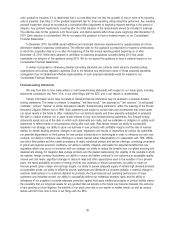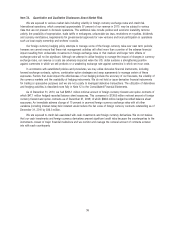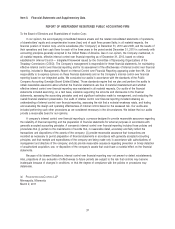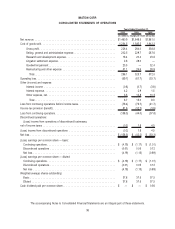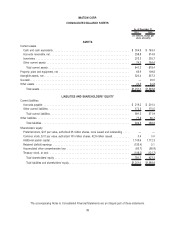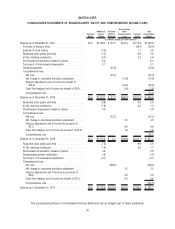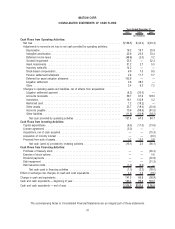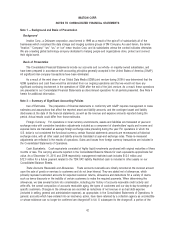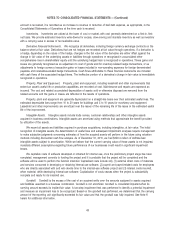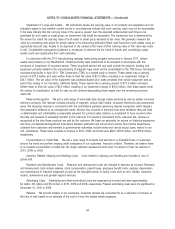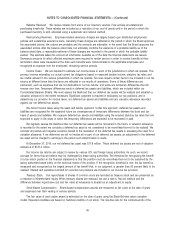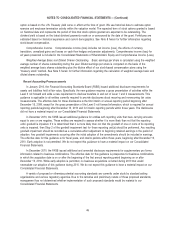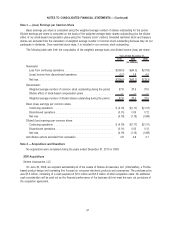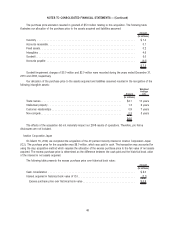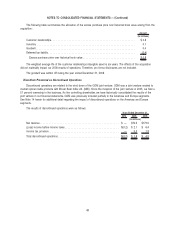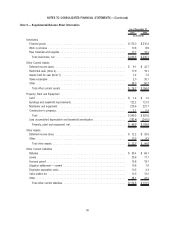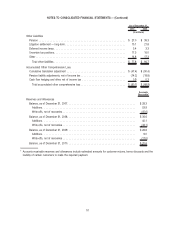Memorex 2010 Annual Report Download - page 48
Download and view the complete annual report
Please find page 48 of the 2010 Memorex annual report below. You can navigate through the pages in the report by either clicking on the pages listed below, or by using the keyword search tool below to find specific information within the annual report.Rebates Received. We receive rebates from some of our inventory vendors if we achieve pre-determined
purchasing thresholds. These rebates are included as a reduction of our cost of goods sold in the period in which the
purchased inventory is sold, allocated using a systematic and rational method.
Restructuring Reserves. Employee-related severance charges are largely based upon distributed employment
policies and substantive severance plans. Generally, these charges are reflected in the period in which the Board approves
the associated actions, the actions are probable and the amounts are estimable. In the event that the Board approves the
associated actions after the balance sheet date, but ultimately confirms the existence of a probable liability as of the
balance sheet date, a reasonable estimate of these charges are recorded in the period in which the probable liability
existed. This estimate takes into account all information available as of the date the financial statements are issued.
Severance amounts for which affected employees were required to render service in order to receive benefits at their
termination dates were measured at the date such benefits were communicated to the applicable employees and
recognized as expense over the employees’ remaining service periods.
Income Taxes. We are required to estimate our income taxes in each of the jurisdictions in which we operate. This
process involves estimating our actual current tax obligations based on expected taxable income, statutory tax rates and
tax credits allowed in the various jurisdictions in which we operate. Tax laws require certain items to be included in our tax
returns at different times than the items are reflected in our results of operations. Some of these differences are
permanent, such as expenses that are not deductible in our tax returns, and some are temporary differences that will
reverse over time. Temporary differences result in deferred tax assets and liabilities, which are included within our
Consolidated Balance Sheets. We must assess the likelihood that our deferred tax assets will be realized and establish a
valuation allowance to the extent necessary. Significant judgment is required in evaluating our tax positions, and in
determining our provision for income taxes, our deferred tax assets and liabilities and any valuation allowance recorded
against our net deferred tax assets.
We record income taxes using the asset and liability approach. Under this approach, deferred tax assets and
liabilities are recognized for the expected future tax consequences of temporary differences between the book and tax
basis of assets and liabilities. We measure deferred tax assets and liabilities using the enacted statutory tax rates that are
expected to apply in the years in which the temporary differences are expected to be recovered or paid.
We regularly assess the likelihood that our deferred tax assets will be recovered in the future. A valuation allowance
is recorded to the extent we conclude a deferred tax asset is not considered to be more-likely-than-not to be realized. We
consider all positive and negative evidence related to the realization of the deferred tax assets in assessing the need for a
valuation allowance. If we determine we will not realize all or part of our deferred tax assets, an adjustment to the deferred
tax asset will be charged to earnings in the period such determination is made.
At December 31, 2010, our net deferred tax asset was $17.9 million. These deferred tax assets are net of valuation
allowance of $127.4 million.
Our income tax returns are subject to review by various U.S. and foreign taxing authorities. As such, we record
accruals for items that we believe may be challenged by these taxing authorities. The threshold for recognizing the benefit
of a tax return position in the financial statements is that the position must be more-likely-than-not to be sustained by the
taxing authorities based solely on the technical merits of the position. If the recognition threshold is met, the tax benefit is
measured and recognized as the largest amount of tax benefit that, in our judgment, is greater than 50 percent likely to be
realized. Interest and penalties recorded for uncertain tax positions are included in our income tax provision.
Treasury Stock. Our repurchases of shares of common stock are recorded as treasury stock and are presented as
a reduction of shareholders’ equity. When treasury shares are reissued, we use a last-in, first-out method and the
difference between repurchase cost and fair value at reissuance is treated as an adjustment to equity.
Stock-Based Compensation. Share-based compensation awards are measured at fair value at the date of grant
and expensed over their vesting or service periods.
The fair value of each option award is estimated on the date of grant using the Black-Scholes option valuation
model. Expected volatilities are based on historical volatility of our stock. The risk-free rate for the contractual life of the
45
NOTES TO CONSOLIDATED FINANCIAL STATEMENTS — (Continued)


